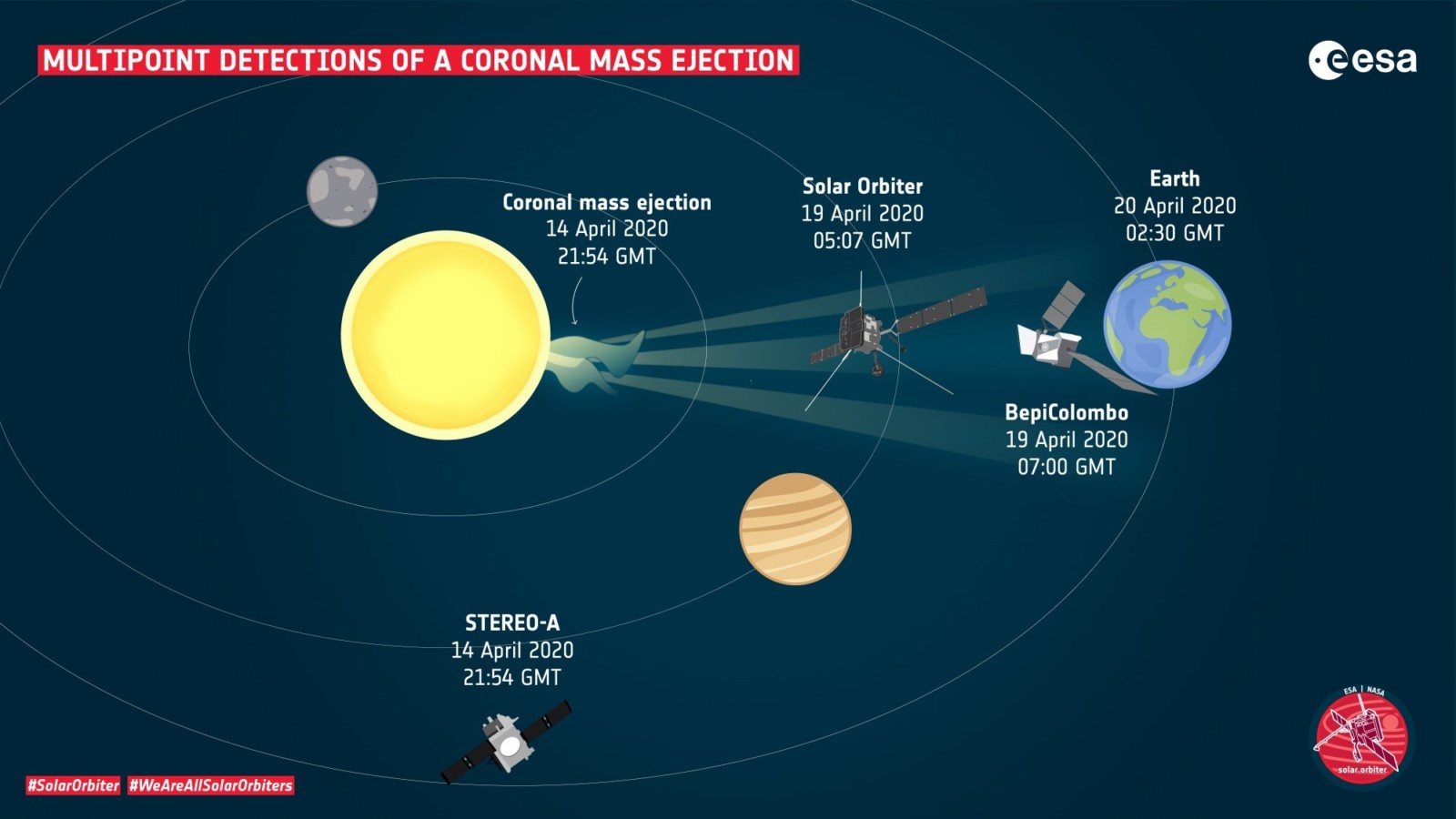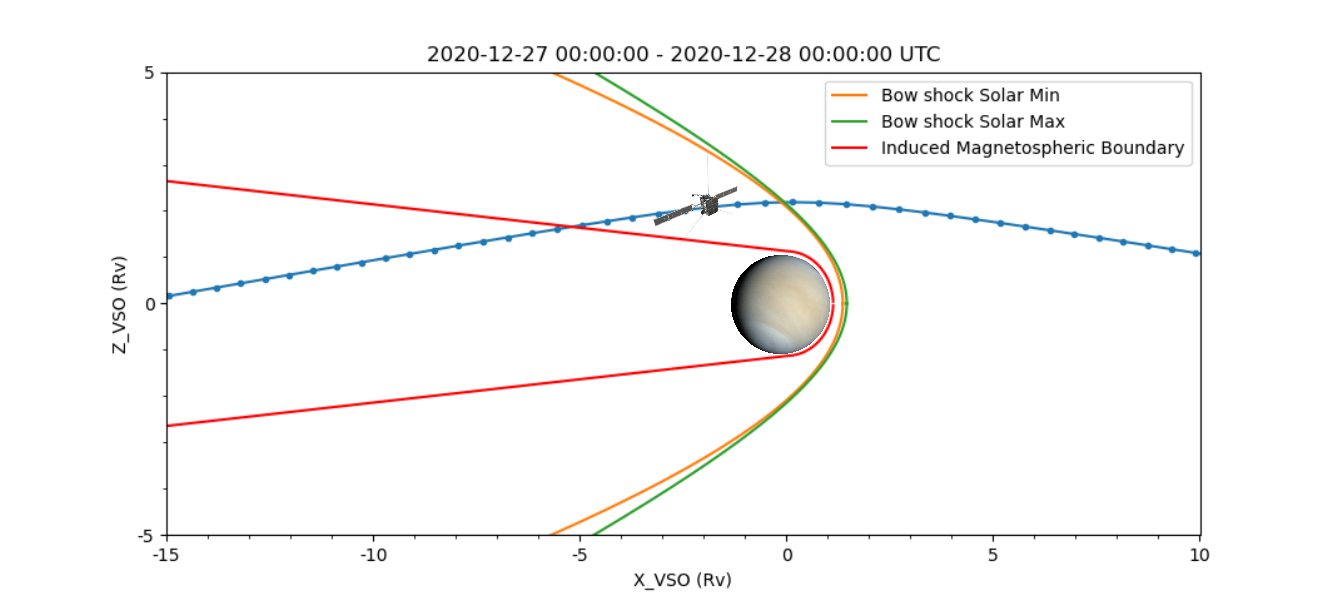
One year ago, the Energetic Particle Detector (EPD) aboard the European Space Agency’s (ESA’s) Sun observing spacecraft Solar Orbiter (SolO) was launched starting a long-awaited journey. SolO (Figure 1) will provide both in-situ and remote sensing measurements in the inner Heliosphere and EPD will contribute particularly to the latter ones.
EPD consists of four sensors that share the same Instrument Control Unit (ICU) (Rodríguez-Pacheco et al. 2020). These units are: STEP (Supra-Thermal Electron Proton) a sensor that measures electrons and ions with energies between 4 keV (~6 keV for ions) and 80 keV with high pitch-angle resolution around the nominal interplanetary magnetic field direction, SIS (Suprathermal Ion Spectrograph) that measures the elemental and isotopic composition of ions in the energy range from approximately 14 keV/nuc to ~ 20.5 MeV/nuc with its two large-aperture viewing directions, EPT that provides information about electrons and ions with energies between 25 keV and 400 keV (6.9 MeV and beyond for ions) in four look directions and HET (High-Energy Telescope) that shares the electronic box with EPT and measures electrons and ions from 300 keV to 30 MeV and 6.8 MeV to > 100 MeV/nuc respectively. Both, EPT and HET have four look directions covering the particles´ directional information sunward and anti-sunward directions and North and South from the ecliptic plane.
During this first year, EPD has recorded several energetic particle events at distances between 0.5 and 1 AU from the Sun (see Figure 2) and completed its first gravity assist maneuver with Venus (VGAM) (see Figure 5). Altogether, the first EPD results already provide a glimpse of what’s coming next; exciting science on a first-class mission to study the Sun close and at high latitudes.
During the first year of EPD operations, several scientific topics have been covered despite being at Solar Minimum, including Corotating Interaction Regions (CIR) and Quiet time studies, Coronal Mass Ejections (CME) related works, Venus and Comet Atlas close flyby observations, and of course Solar Energetic Particles (SEP). All these topics and related publications using our first EPD data, have been addressed in a dedicated upcoming special issue of Astronomy and Astrophysics.

Electrons (inner) and Ions (outer) intensities measured with EPD/EPT represented along SolO orbit during the first year of operations. Credits: J. von Forstner, A. Kollhoff, EPD team Solar Orbiter (ESA & NASA)
From the very beginning of the mission, even with a very quiet Sun, it has been possible to perform studies from small particle intensity increases due to corotating interaction regions (CIRs) (Allen et al. 2020), and even to the background of particles in the quiet inner Heliosphere (Mason et al. 2020). These studies performed at several radial distances from the Sun, show not only the low background level of the sensors, but also interesting scientific topics to be covered during the deep solar minimum.
Concerning the sensors background and cosmic-rays (CR) which is its main source, F. von Forstner et al. 2021, investigated the Forbush decrease (the decline of CR flux due to an expanding ICME sweeping away CR incoming particles) caused by the first ICME observed by SolO EPD/HET on 19/20 April which happens to be a multipoint event also observed at Earth, STA and BepiColombo (Kilpua et al. 2021, accepted in A&A).
This study exemplifies EPD data supporting a wide variety of observations with other facilities to what in fact constitute a constellation of observatories dedicated to the study of the heliosphere and the Sun (Figure. 3).
Starting the Cruise Phase of the mission in June 2020, EPD came across some interesting particle enhancements, such as the early 18-20 June particle event studied by Aran et al. 2020, very close the first perihelium, in which a small particle event is observed in EPT/HET with absence of electrons and Type III radio-bursts suggesting an interplanetary origin.
Another example of such events is shown in Mason et al. (2021) in which EPD/SIS phenomenal mass resolution capabilities are used in the analysis of a series of five 3He-rich impulsive events recorded between July and September 2020 with solar distances between 0.5 and 0.9 AU. 3He-rich events are among the most striking composition anomalies found in particle populations in solar energetic particles with 3He/4He ratios orders of magnitude larger than in the solar wind. This work, being the first article accepted for publication with Solar Orbiter data, presents in addition a detailed study of the composition of heavy ions during the July 20th event. On top of these events, Bucik et al study yet another 3He-rich event of spanning along 7 days associated with several solar injections.
One of the most crucial highlights of this first year of EPD data were the first intense near-relativistic electron events observed by Solar Orbiter (Gómez-Herrero et al. 2021) that took place in July 2020 (See Figure 4). These events were detected by EPT and STEP sensors and its solar origin was confirmed by associated Type III radiobursts and EUV jets observations. Being the first electron events measured by EPD, it was an exciting moment that indeed demonstrated the EPD capabilities in the electron channels and the very good angular coverage.

Electron intensity as a function of time and (inverse) particle speed as observed by STEP and EPT during the events of July 2020. From the delay between faster and slower electrons, it is possible to derive the time at which the electrons were released at the Sun and the path length traveled. Adapted from Gomez-Herrero et al., 2021
During the first year, another focal point came from the first widespread event in November 29th of the awakening Solar Cycle (Kolhoff et al. 2021 submitted to A&A). The event spreading over more than 230 deg in longitude, was also a multi-spacecraft event, being observed by SolO, Parker Solar Probe (PSP), STEREO-A, and ACE. Widespread events offer a rare opportunity to study the potential underlying processes that produce them, including the existence of extended source regions, transport process, perpendicular diffusion, etc … especially if measured from a wide array of instruments at different locations within the heliosphere. They are of particular interest also from the modelling perspective as it allows to test simulations with several data sources of both in-situ and remote sensing instruments.
However, the scope of EPD data is not limited to Solar and Heliospheric particle phenomena. During the mission, EPD data will also provide a unique opportunity to study Solar System bodies particle measurements. Solar Orbiter utilizes gravity assists from Venus to elevate above the equatorial plane therefore allowing for detailed measurements of the planet induced magnetosphere and the Venusian system. The first VGAM took place on December 27th, 2020. During the flyby and despite the complexity of the maneuver, some EPD sensors were switched on as described in Allen et al. (A&A submitted 2021). In this work, bursty enhancements of the suprathermal ion flux measured with STEP are shown as SolO crosses the Venusian magnetotail and downtail magnetosheath regions. During the closest encounter, EPD high energy telescope HET observed also a depletion of the CR flux due to the shadow of Venus. This is the first of the seven VGAM planned throughout the mission that surely will provide new opportunities to further characterize the Venusian system.
In addition to Venus encounters, additional interesting configurations arise from rendez-vous with cometary tails, such as the May/June C/2019 Y4 ATLAS comet tail crossing (Jones et al. 2020)
For the interested reader who wants to deepen on all the aspects mentioned above and understand better the instrument and its data, we encourage the reading of the first year of EPD data summary (Wimmer-Scheingruber et al. 2021, submitted to A&A).
In summary, it has been a year full of surprises and exciting science with SolO/EPD, and we are eagerly awaiting the Sun to wake up and leave the deep solar minimum. Stay tuned for exciting science with EPD.
Quick look plots of EPD data can be found at: http://espada.uah.es/epd/data/plots/quicklook
References:
[1] Rodríguez-Pacheco et al. 2020, A&A, https://doi.org/10.1051/0004-6361/201935287.
[2] Allen et al. 2020, A&A, https://doi.org/10.1051/0004-6361/202039870.
[3] Mason et al. 2020, A&A. https://doi.org/10.1051/0004-6361/202140540.
[4] Von Forstner et al. 2020, A&A https://doi.org/10.1051/0004-6361/202039848.
[5] Kilpua et al. 2020, Energetic Proton Enhancement in the steath of a Interplanetary Coronal Mass Ejection, Accepted in A&A.
[6] Allen et al. 2021, Energetic Ions in Venus System during Solar Orbiter flyby, submitted to A&A.
[7] Mason et al. 2021, A&A, https://doi.org/10.1051/0004-6361/202039752.
[8] Gomez-Herrero et al. 2021, A&A https://doi.org/10.1051/0004-6361/202039883.
[9] Kolhoff et al. 2021, The first widespread Solar Energetic Particle Event observed by Solar Orbiter on 2020 November 29, submitted to A&A.
[10] Aran et al. 2020, The Low-Energy Ion event on 19 June 2020 Measured by Solar Orbiter, conference talk.
[11] Bucik et al. 2021, The long period of He3-rich solar energetic particles measured by Solar Orbiter on 2020 November 17-23. submitted to A&A.
[12] Wimmer-Schweingruber et al. 2021, The first year of energetic particle measurements in the inner heliosphere with Solar Orbiter’s Energetic Particle Detector, submitted to A&A.
[13] Jones et al. 2020, Res. Notes AAS, https://doi.org/10.3847/2515-5172/ab8fa6


